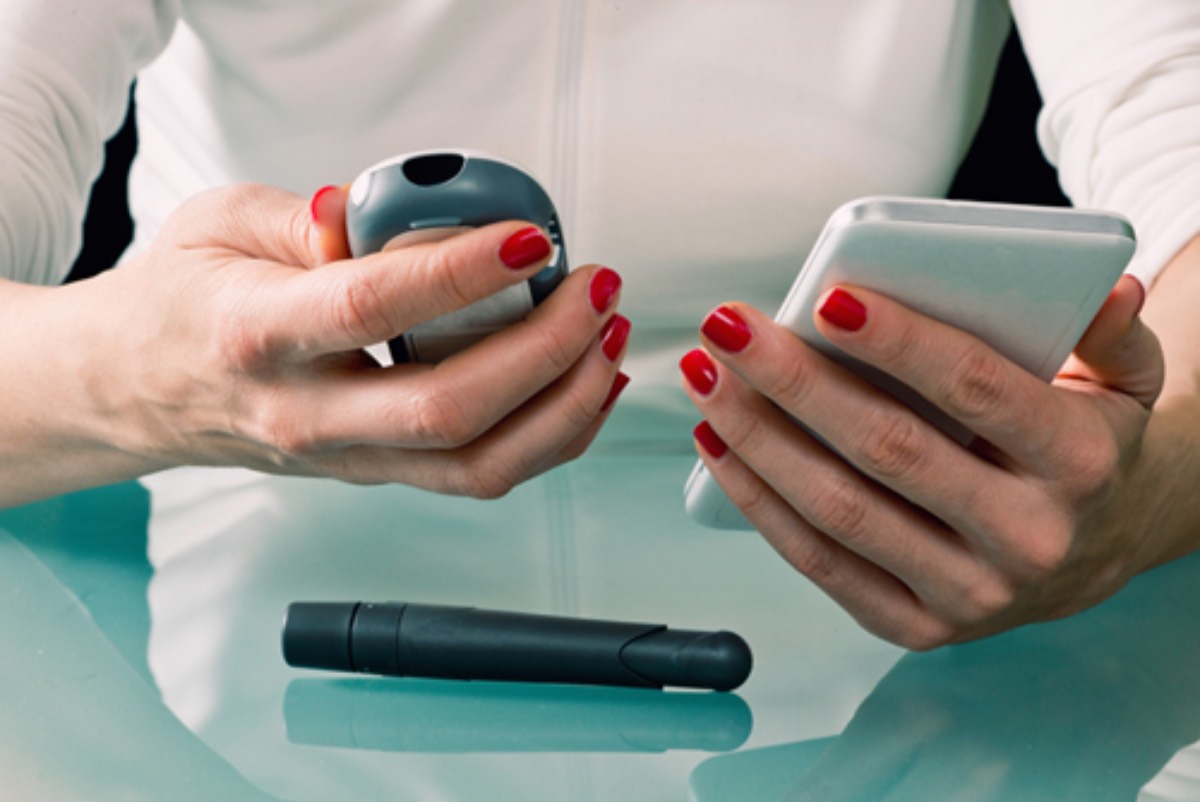Continuous Glucose Monitoring
On this page:
- What is continuous glucose monitoring?
- How does a continuous glucose monitor work?
- Who can use a continuous glucose monitor?
- What are the different types of continuous glucose monitors?
- What are some features of continuous glucose monitors?
- What are the benefits of a continuous glucose monitor?
- What issues could you have while using a continuous glucose monitor?
- What is an artificial pancreas?
- How does NIDDK support research on continuous glucose monitors?
- Clinical Trials on Continuous Glucose Monitors
What is continuous glucose monitoring?
Continuous glucose monitoring means using a device to automatically estimate your blood glucose level, also called blood sugar, throughout the day and night. You can see what your blood glucose level is at any time. You can also review how your blood glucose level changes over a few hours or days and spot trends.
Seeing your blood glucose levels in real time can help you make more informed decisions about the food and beverages you consume, the physical activity you do, and the medicines you take. Keeping your blood glucose level in your target range can help prevent other health problems caused by diabetes.
How does a continuous glucose monitor work?
A continuous glucose monitor (CGM) estimates what your glucose level is every few minutes and keeps track of it over time.
A CGM has three parts. First, there is a tiny sensor that can be inserted under your skin, often the skin on your belly or arm, with a sticky patch that helps it stay there. These sensors are called disposable sensors. Another type of CGM sensor—called an implantable sensor—may be placed inside your body. CGM sensors estimate the glucose level in the fluid between your cells, which is very similar to the glucose level in your blood. Sensors must be replaced at specific times, such as every few weeks, depending on the type of sensor you have.
The second part of the CGM is a transmitter. The transmitter sends the information, without using wires, to the third part, a software program that is stored on a smartphone, on an insulin pump, or on a separate device called a receiver.
 Most CGMs send information without using wires to an app on a smartphone.
Most CGMs send information without using wires to an app on a smartphone.
Who can use a continuous glucose monitor?
Your doctor may recommend that you use a CGM if you need insulin to manage type 1 diabetes, type 2 diabetes, or another form of diabetes. Talk with your doctor about whether using a CGM could help you manage your diabetes.
Doctors can prescribe CGMs for adults and children. Some models can be used for children as young as 2 years old.
Your doctor may suggest using a CGM all the time or only for a few days to help adjust your diabetes care.
What are the different types of continuous glucose monitors?
All CGMs estimate blood glucose levels, but they store and display the information in different ways.
Some CGMs send and display information to your smartphone or receiver automatically. These CGMs are called “real-time” CGM devices. Another type of CGM, called “intermittent-scan,” estimates glucose levels continuously. But you will need to scan the CGM with a separate receiver or smartphone every few hours to view and store the data. A third type of CGM collects data about your blood glucose level for your doctor to download and review later. Doctors provide this type of CGM to check on your diabetes care, and you wear it for a limited time.
Other differences between CGM models include
- whether the sensor is placed on the skin or is implanted
- how often the sensor has to be replaced
- how long it takes the CGM to warm up
- how you adjust the program settings
For some CGM models, you may need to do a finger-stick test with a standard blood glucose monitor to calibrate the system and make sure the CGM readings are correct.
What are some features of continuous glucose monitors?
When worn, CGMs are always on and recording glucose levels—whether you’re showering, working, exercising, or sleeping. Many CGMs work with apps that have special features, such as
- ways to track the food and beverages you consume, your physical activity level, and the medicines you take
- the ability to download data onto a computer or smart device so you can easily see trends in your glucose levels
- an alarm that goes off when your glucose level is too low or too high, helping you prevent emergencies
For safety, it is important to act quickly if a CGM alarm sounds when your glucose level is too low or too high. You should get help or follow your treatment plan to bring your glucose level into a healthy range. Some CGM models can also send information to a second person’s smartphone—such as a parent, partner, or caregiver. For example, if a child’s glucose level drops dangerously low overnight, the CGM could be set to wake a parent in the next room.
What are the benefits of a continuous glucose monitor?
Compared with a standard blood glucose meter, using a CGM can help you
- better manage your glucose levels every day
- have fewer low blood glucose emergencies
- need fewer finger sticks
The CGM will create an alert and might display a graphic that shows whether your glucose level is rising or dropping—and how quickly—so you can choose the best way to reach your target range.
Over time, keeping your glucose levels in the healthy range can help you stay well and prevent diabetes complications. The people who benefit the most from a CGM are those who use it every day or nearly every day.
What issues could you have while using a continuous glucose monitor?
Researchers are working to make CGMs more accurate and easier to use. However, you may experience some issues while using a CGM.
For safety, you may sometimes need to compare your CGM glucose readings with a finger-stick test and a standard blood glucose meter. This could be needed if you doubt the accuracy of your CGM readings, if you are changing your insulin dose, or if your CGM gives a warning alert.1
You might have to replace parts of your CGM over time. Disposable CGM sensors should be replaced every 7 to 14 days, depending on the model. Some implantable sensors can last up to 180 days. You may have to replace the transmitters of some CGMs. You may also need to reconnect the CGM, transmitter, and receiver or smartphone if your CGM is not working correctly.
Skin redness or irritation from the sticky patches used to attach the sensor may occur for some people.1 Your doctor can suggest techniques or medicines to help relieve skin problems.
A CGM costs more than using a standard glucose meter, but it may be covered by your health insurance. You might be able to get financial help for diabetes care from your health insurance or other resources. Check with your health insurance plan or Medicare to see if the costs will be covered.
 For safety, you may sometimes need to compare your CGM glucose readings with a finger-stick test and a standard blood glucose meter.
For safety, you may sometimes need to compare your CGM glucose readings with a finger-stick test and a standard blood glucose meter.
What is an artificial pancreas?
An artificial pancreas, also called an automated insulin delivery system (AID), mimics how a healthy pancreas controls blood glucose in the body. A CGM, an insulin pump, and a software program that shares information between the CGM and insulin pump make up the artificial pancreas.
The CGM estimates glucose levels and wirelessly sends the information to a software program on a smartphone or insulin pump. The program calculates how much insulin your body needs, and the insulin pump delivers the insulin when glucose levels rise higher than your target range. On the other hand, if your glucose levels fall lower than your target range, the artificial pancreas can lower or stop the amount of insulin given by the insulin pump.
The artificial pancreas is mainly used to help people with type 1 diabetes keep their glucose levels in their target range.
How does NIDDK support research on continuous glucose monitors?
NIDDK has a long-standing commitment to funding research to better understand diabetes and improve the lives of people with the disease.
NIDDK-funded research helped scientists learn that glucose levels in the fluid between cells could be used to estimate blood glucose levels.2 This discovery helped create the CGMs that people with diabetes use today.
NIDDK also supported the Diabetes Control and Complications Trial, which showed that people with diabetes could use blood glucose monitors at home to closely control their blood glucose levels and reduce their risk of health problems.3
Clinical Trials on Continuous Glucose Monitors
NIDDK conducts and supports clinical trials for many diseases and conditions, including diabetes. Trials look for new ways to prevent, detect, or treat disease and improve quality of life.
What are clinical trials for continuous glucose monitors?
Clinical trials—and other types of clinical studies—are part of medical research and involve people like you. When you volunteer to take part in a clinical study, you help doctors and researchers learn more about disease and improve health care for people in the future. Researchers are studying many aspects of CGMs, such as how CGMs could be made more sensitive, reliable, and comfortable to wear. Researchers are also studying how they might be used to manage different types of diabetes or other medical conditions.
Find out if clinical studies are right for you.
Watch a video of NIDDK Director Dr. Griffin P. Rodgers explaining the importance of participating in clinical trials.
What clinical studies on continuous glucose monitors are looking for participants?
You can view a filtered list of clinical studies that use CGMs and are federally funded, open, and recruiting at ClinicalTrials.gov. You can expand or narrow the list to include clinical studies from industry, universities, and individuals; however, the National Institutes of Health does not review these studies and cannot ensure they are safe. Always talk with your health care provider before you participate in a clinical study.
References
This content is provided as a service of the National Institute of Diabetes and Digestive and Kidney Diseases
(NIDDK), part of the National Institutes of Health. NIDDK translates and disseminates research findings to increase knowledge and understanding about health and disease among patients, health professionals, and the public. Content produced by NIDDK is carefully reviewed by NIDDK scientists and other experts.
NIDDK would like to thank:
Jenise C. Wong, M.D., Ph.D., University of California San Francisco, School of Medicine

